Daniel Dewar & Grégory Gicquel
Mammalian Fantasies
18 Jan - 14 Apr 2019
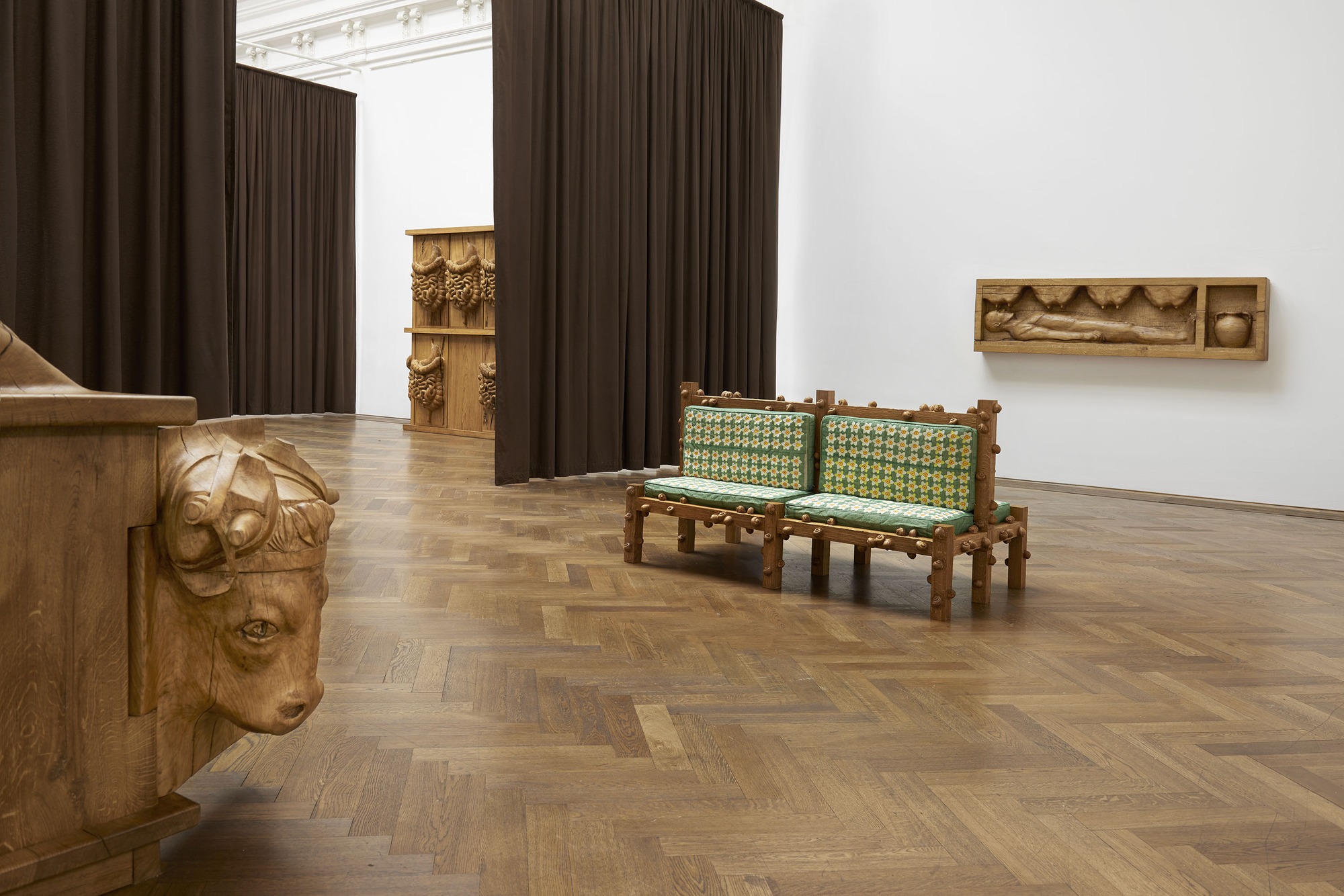
Daniel Dewar & Grégory Gicquel, installation view, Mammalian Fantasies, Kunsthalle Basel, 2019. Photo: Philipp Hänger / Kunsthalle Basel. Courtesy of the artists; C L E A R I N G, New York / Brussels; Loevenbruck, Paris, and Jan Kaps, Cologne
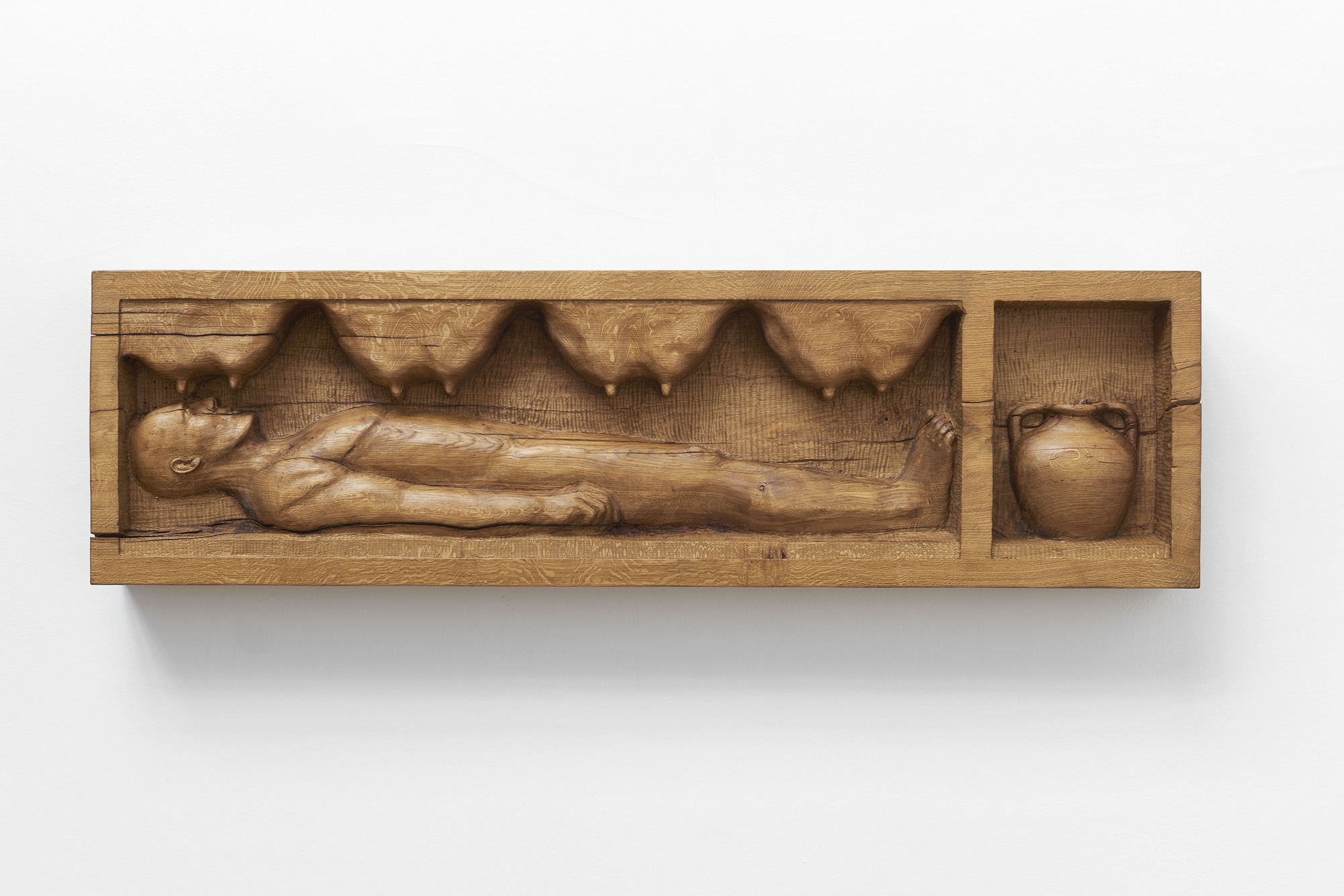
Daniel Dewar & Grégory Gicquel, installation view, Mammalian Fantasies, view on, Oak Relief with Man, Udders, and Vase, 2017, Kunsthalle Basel, 2019. Photo: Philipp Hänger / Kunsthalle Basel. Courtesy of the artists; C L E A R I N G, New York / Brussels; Loevenbruck, Paris, and Jan Kaps, Cologne

Daniel Dewar & Grégory Gicquel, installation view, Mammalian Fantasies, view on (f.l.t.r.) Oak Dresser with Harnessed Oxen, 2017, Oak Bench with Narcissus and Snails, 2017, Kunsthalle Basel, 2019. Photo: Philipp Hänger / Kunsthalle Basel. Courtesy of the artists; C L E A R I N G, New York / Brussels; Loevenbruck, Paris, and Jan Kaps, Cologne
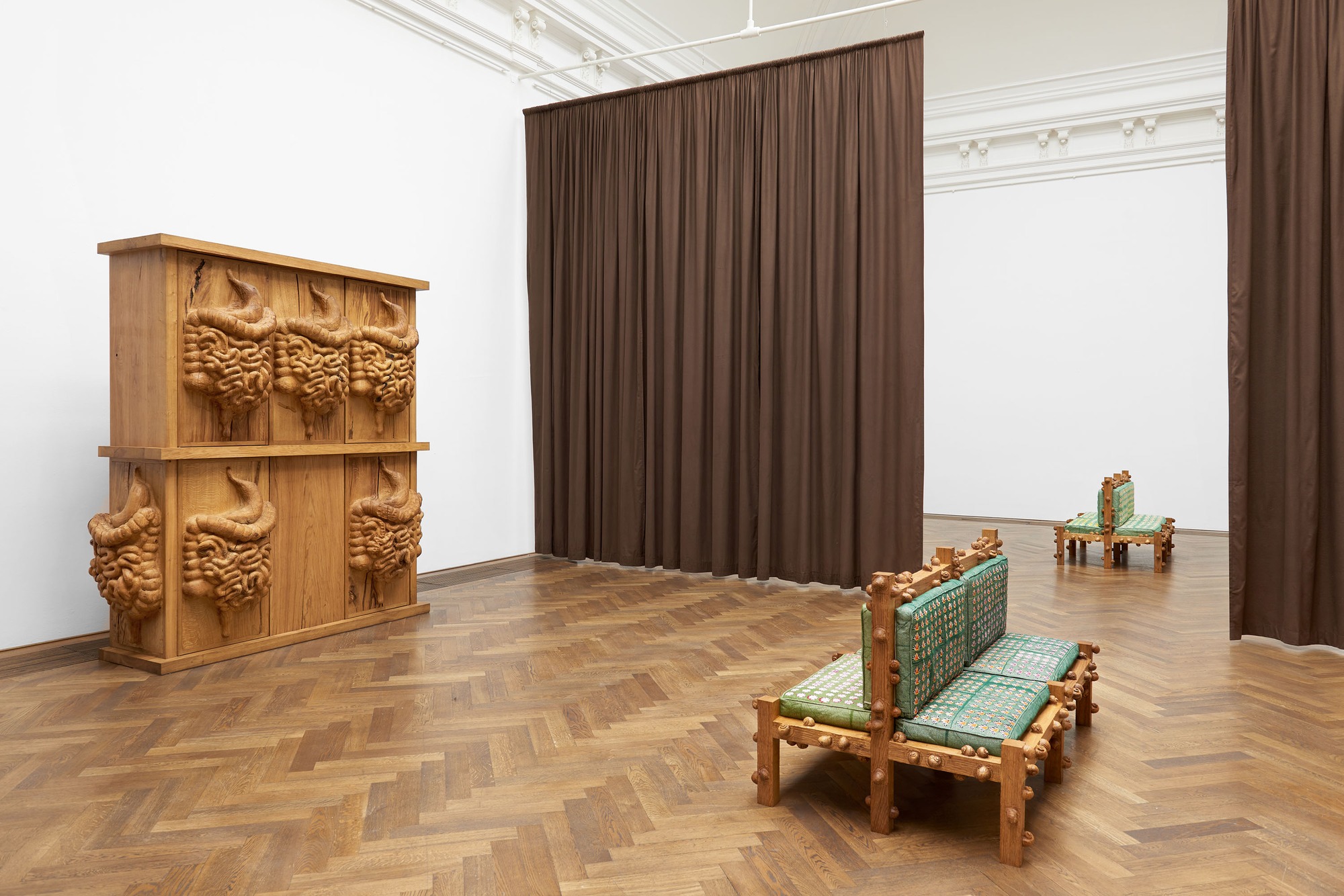
Daniel Dewar & Grégory Gicquel, installation view, Mammalian Fantasies, Kunsthalle Basel, 2019. Photo: Philipp Hänger / Kunsthalle Basel. Courtesy of the artists; C L E A R I N G, New York / Brussels; Loevenbruck, Paris, and Jan Kaps, Cologne
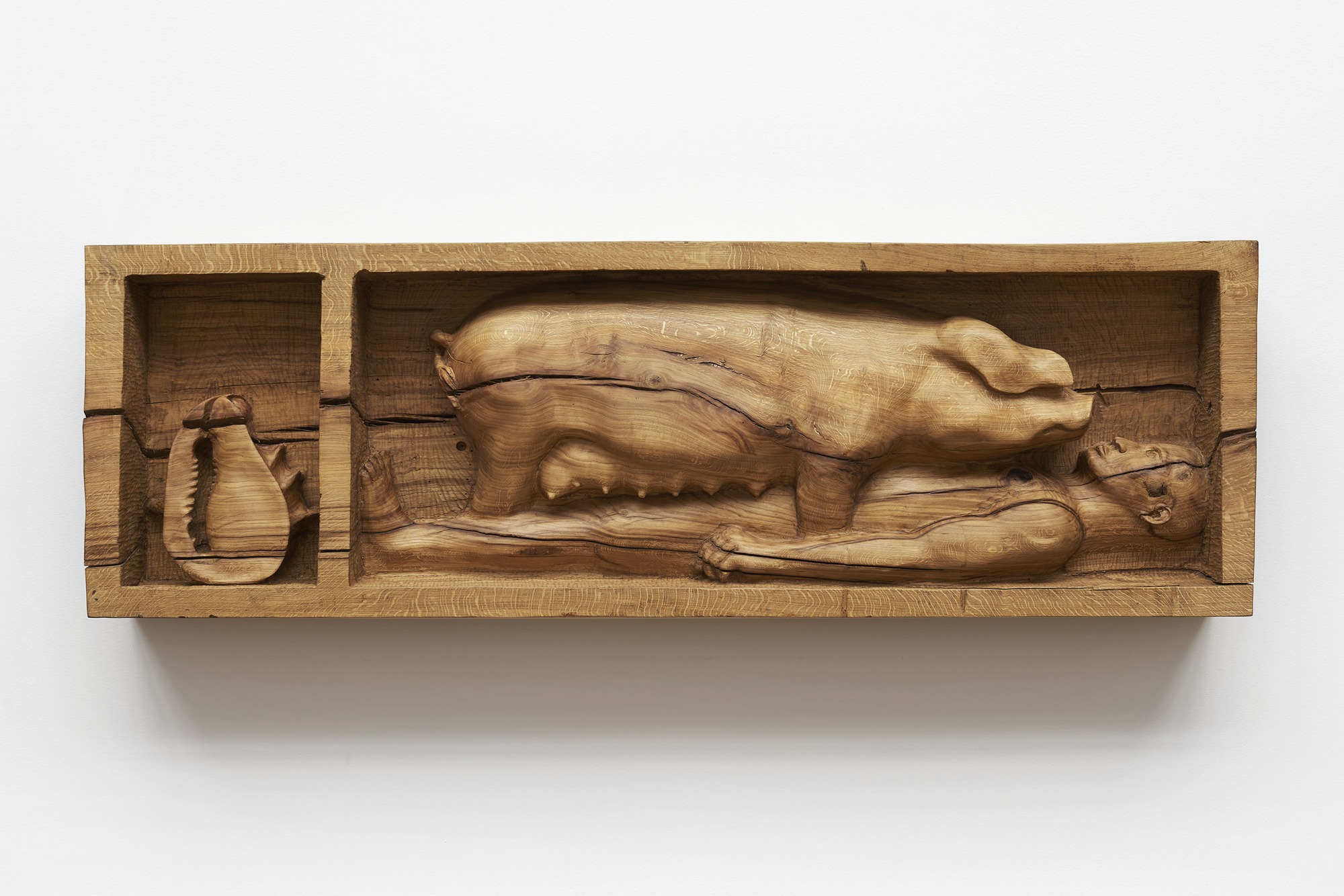
Daniel Dewar & Grégory Gicquel, installation view, Mammalian Fantasies, view on, Oak Relief with Man, Pig, and Shell, 2018, Kunsthalle Basel, 2019. Photo: Philipp Hänger / Kunsthalle Basel. Courtesy of the artists; C L E A R I N G, New York / Brussels; Loevenbruck, Paris, and Jan Kaps, Cologne

Daniel Dewar & Grégory Gicquel, installation view, Mammalian Fantasies, Kunsthalle Basel, 2019. Photo: Philipp Hänger / Kunsthalle Basel. Courtesy of the artists; C L E A R I N G, New York / Brussels; Loevenbruck, Paris, and Jan Kaps, Cologne
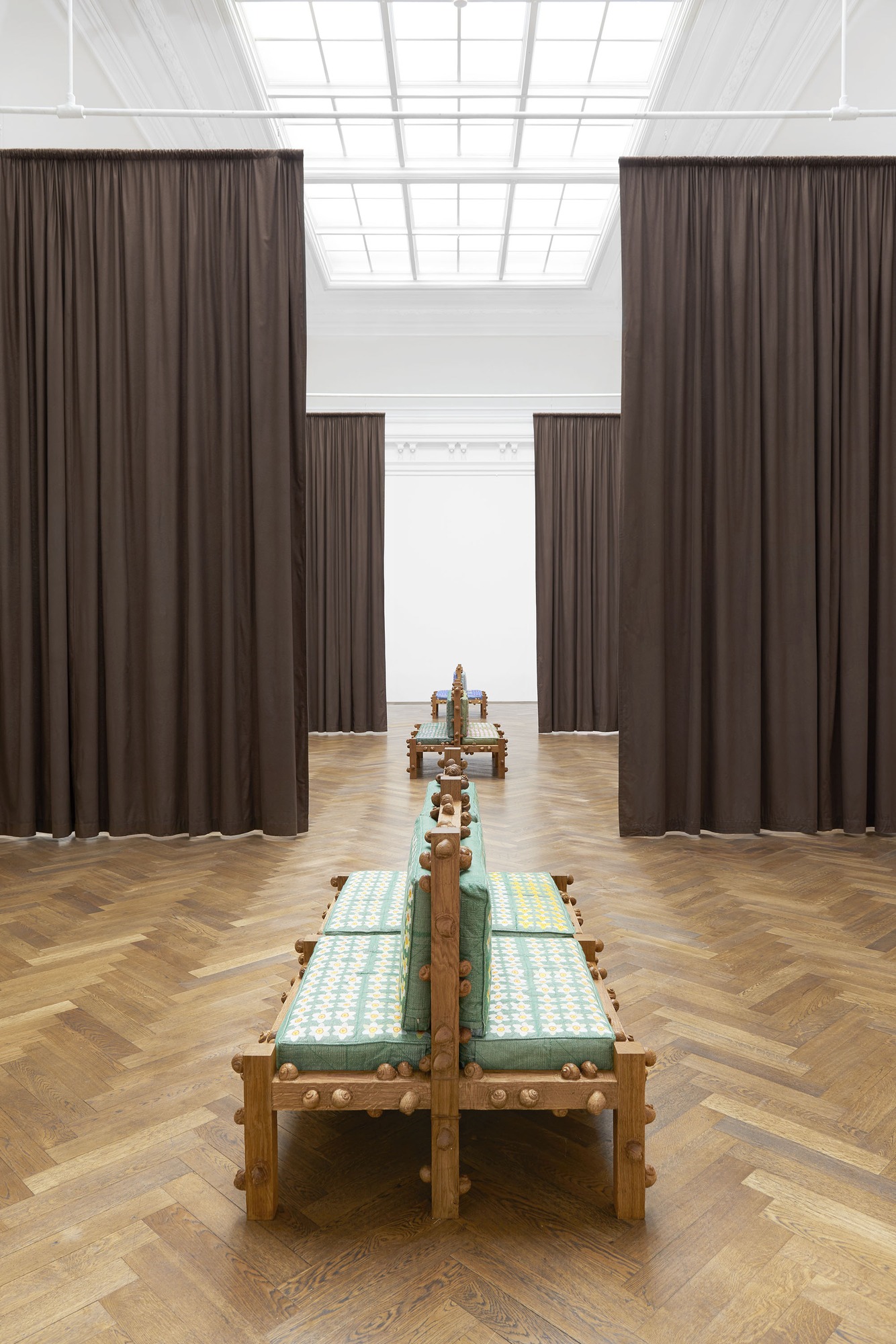
Daniel Dewar & Grégory Gicquel, installation view, Mammalian Fantasies, Kunsthalle Basel, 2019. Photo: Philipp Hänger / Kunsthalle Basel
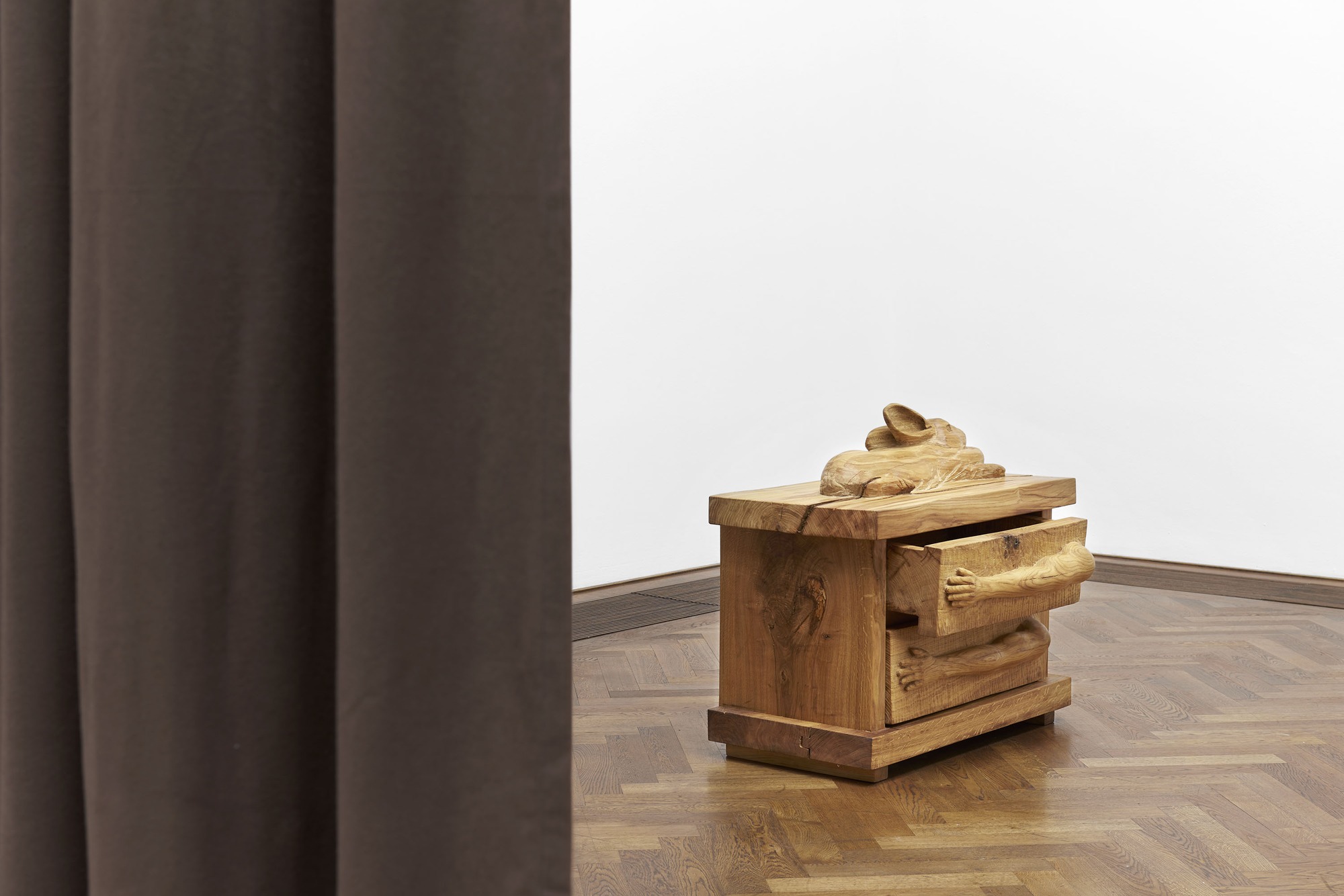
Daniel Dewar & Grégory Gicquel, installation view, Mammalian Fantasies, view on, Oak Chest of Drawers with Giant Flanders Rabbit and Arms, 2018, Kunsthalle Basel, 2019. Photo: Philipp Hänger / Kunsthalle Basel. Courtesy of the artists; C L E A R I N G, New York / Brussels; Loevenbruck, Paris, and Jan Kaps, Cologne

Daniel Dewar & Grégory Gicquel, installation view, Mammalian Fantasies, Kunsthalle Basel, 2019. Photo: Philipp Hänger / Kunsthalle Basel. Courtesy of the artists; C L E A R I N G, New York / Brussels; Loevenbruck, Paris, and Jan Kaps, Cologne
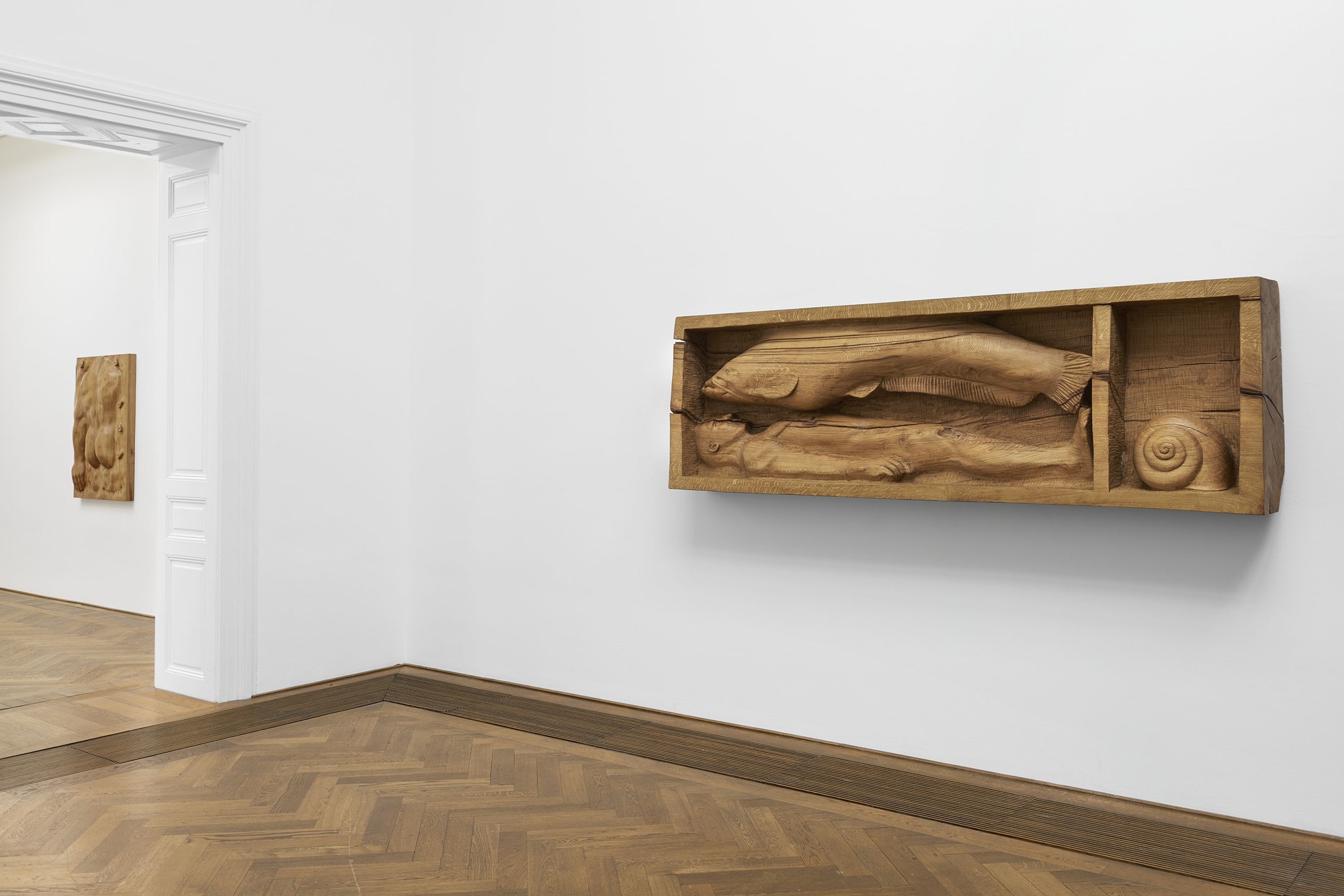
Daniel Dewar & Grégory Gicquel, installation view, Mammalian Fantasies, view on (f.l.t.r.) Oak Relief with Body Fragments, 2018, Oak Relief with Man, Catfish, and Shell, 2017, Kunsthalle Basel, 2019. Photo: Philipp Hänger / Kunsthalle Basel. Courtesy of the artists; C L E A R I N G, New York / Brussels; Loevenbruck, Paris, and Jan Kaps, Cologne
DANIEL DEWAR & GRÉGORY GICQUEL
Mammalian Fantasies
18 January – 14 April 2019
Wading boots, toilets, soap dispensers, sinks, bidets, or even giganti- cally oversize sweaters: all containers enclosing a negative space, corporeal recepta- cles of a sort. Daniel Dewar and Grégory Gicquel’s early sculptures evoked the human bodies that might fill or complete their forms, but never actually represented any bodies at all. It wouldn’t be until 2012, after more than a decade of working together, that the duo turned to the human figure directly. There was a prudishness, they admit, to their hesita- tion to portray that most enduring and central of art history’s subjects. Naked, in pieces, and now overwhelmingly present in their most recent works, the previously elusive human body appears with spectacular aplomb.
This exhibition manifests its central subject— the human, a mammal among mammals—in wood. As is their habit, the British-French duo built the entirety of their exhibition from a single type of material, in this case, wood. And as is also the artists’ habit, they produced everything themselves, using laborious and traditional processes, atypical at a moment when so much artistic production is deskilled, outsourced, and computer generated. They have long refused remote modes of production, not to favor nostalgia for bygone methods, but instead to plumb the depths of the very idea of manufacture in our contemporary digital age.
For years, Dewar and Gicquel—who met in art school in 1998 and have collaborated ever since—have embraced the role of dogged ama- teurs, autodidacts. They taught themselves to work in unfired clay, ceramic, stone, weaving, and, most recently, wood, sometimes even first learning about and then building the very tools (a giant loom, a wood-fired kiln) required to be able to go into production proper. A single piece could take weeks or months, maybe years, of self-education and then intense labor. So important is this strategy that they once declared, “There is no difference between the process of making and the object”—an unusual position given the contemporary art world’s focus on commodifiable results. And while not acting as dilettantes per se (because they clearly do what they do with incredible dedication and seriousness), by choosing to switch materials and processes before they have ever fully mas- tered any one of them, they enact a deliberate refusal of “expertise” and create works that, as a matter of principle, are willfully imperfect.
For this, their first institutional solo exhibition in Switzerland, encompassing new and recent works, Dewar and Gicquel’s idiosyncratic formal language—equal parts folk and pop art—is palpable throughout. This is expressed in wood gouged and carved into the shape of either wall reliefs or useful objects (benches, cabinets, chests of drawers). These feature compositions in which the anonymous male body (not any particular man, but “man”), whole or in fragments, and other living beings insinuate nourishment, strength in unity, or intimacy.
A specially conceived scenography of curtains and deliriously carved benches (to be used as actual seating by visitors) imparts an air of domesticity to the grandeur of the exhibition’s first room. Oak Cabinet with Organs (2017), a monumental armoire decorated with repeated, oversize intestinal tracts, exemplifies the show’s overall strangeness. Lining the walls are three wooden wall reliefs, each cut from a single log, and each composed of two distinct frames, like comic strip panels or scenes in a predella, the narrative supporting base of an altar screen. In one, a recumbent nude male figure and four cow udders in the first frame, then a vase in the next (notice how the duo loves receptacles), together create a sequential effect. Skin touches skin in nearly all of them, with the male figure recalling Hans Holbein’s The Body of the Dead Christ in the Tomb (1521—22), except in the duo’s patently secular version, those udders or a sow or a catfish are positioned oddly, voluptuously, on top of him. Tactile meetings of two different species become weirdly erotic (the show’s title, Mammalian Fantasies, hints at this), with the ubiquitous hollow vessel conceivably a winking innuendo.
In the last rooms, a series of wooden reliefs bear disembodied muscular backs and buttocks and arms, some multiplied and strangely mor- phed, which is odd enough, but somehow not quite as disquieting as the fingers or a full set of toes that protrude from a few of the works, as if emerging from behind the wood itself. All of the works are almost alive in their organic materiality, carefully oiled and waxed, creating a sensuous conflation between wood and represented body (or between the oily secretions of pictured bodies and the sweat of the actual artists’ bodies that made them).
With the exception of the reliefs in the last rooms, all the other works on view were carved from a single block of oak (“monoxylous” is the technical term for this), lending them a certain heft. Rather than sculptures that are built up, bit by bit, in an additive way, form here emerges through a process of reduction: Dewar and Gicquel would tell you that the figures were all already there, just waiting to be excavat- ed. In specific instances, when the artists wanted a certain form to identically repeat in a single work, whether snails or intestines, they combined their usual intensive manual labor with that of a now-obsolete mechanical copy-carving machine. This pre-digital ancestor to a CNC mill requires a handmade 1:1 model as input and is run manually, so the hand remains always present in the process. It is somehow fitting that in Dewar and Gicquel’s world, when man and machine come together, it is in the task of reproduction—given the double sense of the term as an act both technical and sexual, mechanical and corporeal.
There is a persistent strangeness, even impropriety, to this duo’s anatomical-meetszoological-meets-erotic-meets-pastoral iconography, and the fact that it often takes the form of domestic furnishings only makes it more so. And then there is the
issue of their titles. Oak Relief with Man, Udders, and Vase (2017), Oak Chest of Drawers with Giant Flanders Rabbit and Arms (2018), Oak Bench with Narcissus and Snails (2017): Dewar and Gicquel’s artworks are called— dumbly, unadornedly—what they represent. In their unassuming directness, there is something almost deadpan. Which is to say, the artists are not afraid of humor, even a touch of perversity.
But their works are not ha-ha funny. Instead, there is always something at once so literal and yet so surreal as to seem not quite right. The sculptures are carefully crafted and often demonstratively massive, but too light- hearted to be overly precious; they are classically and unabashedly figurative, but don’t attempt to signify quite the way that figuration so often does; they deploy popular, vernacular crafts (and might even from a distance seem plucked from a quiet mountain village home), but undermine the usual language of that tradition; they look old-fashioned, but are equal parts conceptual and utterly contemporary; and finally, their results are comely but some- how too impolite and bewildering to easily please. They are a bundle of contradictions, at once “sublime and ridiculous,” as curator Zoë Gray has noted.
Among the contradictions that the artists court is their insistent pressing of categories. After all, their works ask, what is the difference be- tween a sculpture and a design object, between art and decor, between artist and artisan, between something to be contemplated and something to be used, between high and low? Dewar and Gicquel’s output is hard to place: it is art, to be sure, but relentlessly disturbing and ontologically perplexing art. Yet if the traditional distinction between art and ornament is that art is meant to stimu- late the intellect, while ornament is solely pleasing to the eye and comfortably unengaging to the mind, Dewar and Gicquel challenge this dichotomy. They make sculpture into something alien, uncomfortable, and thus, somehow more itself.
Mammalian Fantasies
18 January – 14 April 2019
Wading boots, toilets, soap dispensers, sinks, bidets, or even giganti- cally oversize sweaters: all containers enclosing a negative space, corporeal recepta- cles of a sort. Daniel Dewar and Grégory Gicquel’s early sculptures evoked the human bodies that might fill or complete their forms, but never actually represented any bodies at all. It wouldn’t be until 2012, after more than a decade of working together, that the duo turned to the human figure directly. There was a prudishness, they admit, to their hesita- tion to portray that most enduring and central of art history’s subjects. Naked, in pieces, and now overwhelmingly present in their most recent works, the previously elusive human body appears with spectacular aplomb.
This exhibition manifests its central subject— the human, a mammal among mammals—in wood. As is their habit, the British-French duo built the entirety of their exhibition from a single type of material, in this case, wood. And as is also the artists’ habit, they produced everything themselves, using laborious and traditional processes, atypical at a moment when so much artistic production is deskilled, outsourced, and computer generated. They have long refused remote modes of production, not to favor nostalgia for bygone methods, but instead to plumb the depths of the very idea of manufacture in our contemporary digital age.
For years, Dewar and Gicquel—who met in art school in 1998 and have collaborated ever since—have embraced the role of dogged ama- teurs, autodidacts. They taught themselves to work in unfired clay, ceramic, stone, weaving, and, most recently, wood, sometimes even first learning about and then building the very tools (a giant loom, a wood-fired kiln) required to be able to go into production proper. A single piece could take weeks or months, maybe years, of self-education and then intense labor. So important is this strategy that they once declared, “There is no difference between the process of making and the object”—an unusual position given the contemporary art world’s focus on commodifiable results. And while not acting as dilettantes per se (because they clearly do what they do with incredible dedication and seriousness), by choosing to switch materials and processes before they have ever fully mas- tered any one of them, they enact a deliberate refusal of “expertise” and create works that, as a matter of principle, are willfully imperfect.
For this, their first institutional solo exhibition in Switzerland, encompassing new and recent works, Dewar and Gicquel’s idiosyncratic formal language—equal parts folk and pop art—is palpable throughout. This is expressed in wood gouged and carved into the shape of either wall reliefs or useful objects (benches, cabinets, chests of drawers). These feature compositions in which the anonymous male body (not any particular man, but “man”), whole or in fragments, and other living beings insinuate nourishment, strength in unity, or intimacy.
A specially conceived scenography of curtains and deliriously carved benches (to be used as actual seating by visitors) imparts an air of domesticity to the grandeur of the exhibition’s first room. Oak Cabinet with Organs (2017), a monumental armoire decorated with repeated, oversize intestinal tracts, exemplifies the show’s overall strangeness. Lining the walls are three wooden wall reliefs, each cut from a single log, and each composed of two distinct frames, like comic strip panels or scenes in a predella, the narrative supporting base of an altar screen. In one, a recumbent nude male figure and four cow udders in the first frame, then a vase in the next (notice how the duo loves receptacles), together create a sequential effect. Skin touches skin in nearly all of them, with the male figure recalling Hans Holbein’s The Body of the Dead Christ in the Tomb (1521—22), except in the duo’s patently secular version, those udders or a sow or a catfish are positioned oddly, voluptuously, on top of him. Tactile meetings of two different species become weirdly erotic (the show’s title, Mammalian Fantasies, hints at this), with the ubiquitous hollow vessel conceivably a winking innuendo.
In the last rooms, a series of wooden reliefs bear disembodied muscular backs and buttocks and arms, some multiplied and strangely mor- phed, which is odd enough, but somehow not quite as disquieting as the fingers or a full set of toes that protrude from a few of the works, as if emerging from behind the wood itself. All of the works are almost alive in their organic materiality, carefully oiled and waxed, creating a sensuous conflation between wood and represented body (or between the oily secretions of pictured bodies and the sweat of the actual artists’ bodies that made them).
With the exception of the reliefs in the last rooms, all the other works on view were carved from a single block of oak (“monoxylous” is the technical term for this), lending them a certain heft. Rather than sculptures that are built up, bit by bit, in an additive way, form here emerges through a process of reduction: Dewar and Gicquel would tell you that the figures were all already there, just waiting to be excavat- ed. In specific instances, when the artists wanted a certain form to identically repeat in a single work, whether snails or intestines, they combined their usual intensive manual labor with that of a now-obsolete mechanical copy-carving machine. This pre-digital ancestor to a CNC mill requires a handmade 1:1 model as input and is run manually, so the hand remains always present in the process. It is somehow fitting that in Dewar and Gicquel’s world, when man and machine come together, it is in the task of reproduction—given the double sense of the term as an act both technical and sexual, mechanical and corporeal.
There is a persistent strangeness, even impropriety, to this duo’s anatomical-meetszoological-meets-erotic-meets-pastoral iconography, and the fact that it often takes the form of domestic furnishings only makes it more so. And then there is the
issue of their titles. Oak Relief with Man, Udders, and Vase (2017), Oak Chest of Drawers with Giant Flanders Rabbit and Arms (2018), Oak Bench with Narcissus and Snails (2017): Dewar and Gicquel’s artworks are called— dumbly, unadornedly—what they represent. In their unassuming directness, there is something almost deadpan. Which is to say, the artists are not afraid of humor, even a touch of perversity.
But their works are not ha-ha funny. Instead, there is always something at once so literal and yet so surreal as to seem not quite right. The sculptures are carefully crafted and often demonstratively massive, but too light- hearted to be overly precious; they are classically and unabashedly figurative, but don’t attempt to signify quite the way that figuration so often does; they deploy popular, vernacular crafts (and might even from a distance seem plucked from a quiet mountain village home), but undermine the usual language of that tradition; they look old-fashioned, but are equal parts conceptual and utterly contemporary; and finally, their results are comely but some- how too impolite and bewildering to easily please. They are a bundle of contradictions, at once “sublime and ridiculous,” as curator Zoë Gray has noted.
Among the contradictions that the artists court is their insistent pressing of categories. After all, their works ask, what is the difference be- tween a sculpture and a design object, between art and decor, between artist and artisan, between something to be contemplated and something to be used, between high and low? Dewar and Gicquel’s output is hard to place: it is art, to be sure, but relentlessly disturbing and ontologically perplexing art. Yet if the traditional distinction between art and ornament is that art is meant to stimu- late the intellect, while ornament is solely pleasing to the eye and comfortably unengaging to the mind, Dewar and Gicquel challenge this dichotomy. They make sculpture into something alien, uncomfortable, and thus, somehow more itself.
